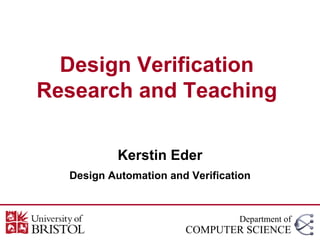
Design Verification Research & Teaching
- 1. Design Verification Research and Teaching Kerstin Eder Design Automation and Verification Department of COMPUTER SCIENCE
- 2. COMSM0115: Design Verification Aim: “To familiarize students with the routine tasks and the latest techniques in design verification, and to give them the theoretical background plus some of the practical skills expected from a professional design verification engineer.”
- 3. Syllabus Introduction to HW Design Flow and Functional Verification Verification Flow and Tools Traditional simulation-based Verification: basic testbench architecture, directed testing, driving & checking tutorial Verification Planning Process Coverage: metrics: structural, functional, analysis, need to combine metrics Automation for Verification: constrained pseudo-random stimulus generation self-checking testbenches Coverage Driven Verification Assertion Based Verification Functional Formal Verification
- 4. Design Verification Research Exploiting state-of-the-art techniques from other areas of CS to advance Design Verification Formal specification, refinement, derivation and verification by mathematical proof Reassessing processor design decisions – impact on verification Coverage Directed Test Generation: Formal approaches Feedback-based approaches – machine learning Methodology development for coverage balancing Industrial Collaboration with: IBM Research Labs in Haifa (Israel) Local semiconductor industry: STM, Infineon, Clearspeed, Xmos, BRCM, Icera etc EDA: Cadence and Mentor Graphics
- 5. Opportunities to get involved Undergraduate student projects – Final year project BSc: 400h (40 CP), part-time, October to May – Final year project MEng: 400h (40 CP), full-time, February to May MSc student projects – 200h (20 CP), part-time, February to May – 600h (60 CP), full-time, June to September PhD – 3 years 6 months full-time research EngD – 4 years full-time research and professional training – 75% of time spent in industry – Portfolio-based Get involved: Contact Kerstin.Eder@bristol.ac.uk to explore collaboration opportunities
- 6. Ramaram Naresh (MSc AMSE student at University of Bristol) Email ID : nr8627@bristol.ac.uk Experience : Worked as Member Technical staff in GD Micro Systems Pvt Ltd for THREE plus years. Interested in : SOC Verification, Analog & Mixed signal design. Domain Expertise : SOC Verification, Reference Verification Methodology & AMBA AHB/APB bus systems. Projects Done : Dual core 2 million gate count System-on-chip using 90nm technology, AHB Verification IP using VERA. Role : Verification of chip at block, system and production level. Languages : C, C++, Verilog, Unix, Perl.